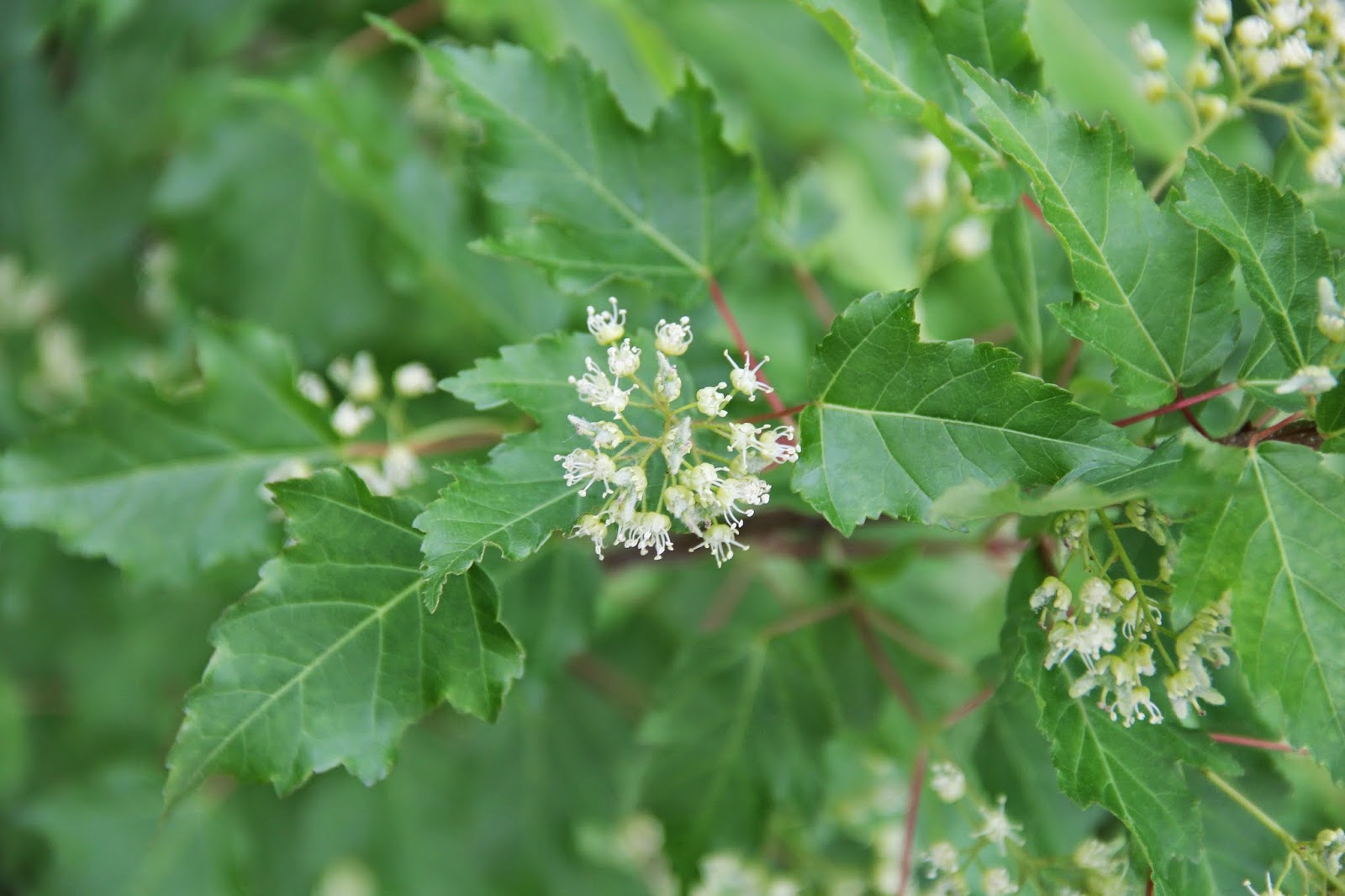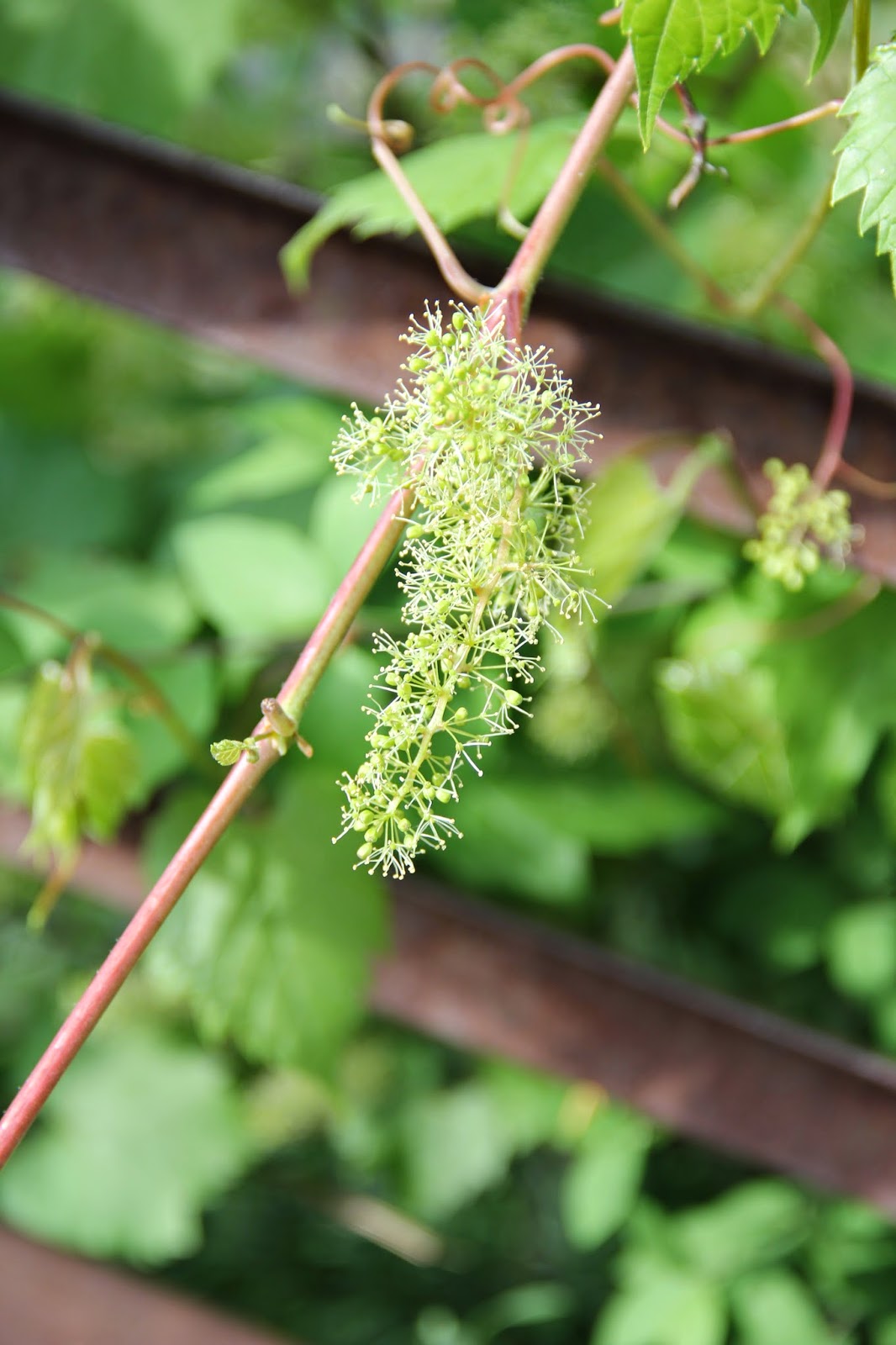Last Tuesday (03 June 2014) I photographed my 99th and 100 species of wildflowers for the year. On the same day, I found and photographed an additional five species. All of these flowers belong to non-native plants.
Wildflowers of 2014 - #101 Winged Euonymus (Euonymus alatus)
Beginning the second hundred flowers of 2014 is Winged Euonymus (Euonymus alatus). Also known as Burning Bush for its red fall foliage, Winged Euonymus is a common landscape shrub that has escaped into the wild throughout the eastern United States. Like most escaped shrubs, it is spread when birds consume its fruit and leave the seeds in their droppings. This shrub was found growing along the Chippewa River behind the Mt. Pleasant City Hall.
 |
| Winged Euonymus - note the flowers with four petals |
This species is named Winged Euonymus for the cork-like wings that project off the sides of its branches and trunks. These wings can be seen on several of the twigs in the photo below.
 |
| Winged Euonymus branches - note the cork-like wings projecting off several of the twigs |
Wildflowers of 2014 - #102 Amur Maple (Acer ginnala)
The next species was found growing alongside the Winged Euonymus. Amur maple (Acer ginnala) is a small tree species that is native to northeast Asia. Like most Maple species it produces large numbers of seeds and can grow rapidly, because of these factors it is potentially invasive. It is currently found growing wild in sixteen northern states and three Canadian provinces. As of right now, it is only found near areas of human habitation.
 |
| Amur Maple (Euonymus ginnala) |
 |
| Amur Maple - note the lobed leaves typical of Maple species |
Wildflowers of 2014 - #103 Black Locust (Robinia pseudoacacia)
The next species is one that I have found growing wild in four of Mt. Pleasant's parks - Black Locust (Robinia pseudoacacia). Native to North America, but not native to Michigan, this species has been extensively planted as a landscape tree. It has since spread into natural areas and may be considered invasive in some areas for this spreading tendency. It frequently grows to a height of 30 to 50 feet, but occasionally tops out at 70 feet. It is currently found in all US states except Hawaii and Alaska and six Canadian provinces.
 |
| A Black Locust tree |
Black Locust can be identified by its large compound leaves, thorns, white pea-like flowers, and flat seed pods. The flower shape identifies this plant as a member of the Legume Family (Fabaceae). Like other legumes, Black Locust forms a symbiotic relationship with certain nitrogen-fixing soil bacteria.
 |
| Black Locust - note large compound leaves and pea-like flowers |
 |
| Black locust - a closer view of the flowers |
 |
| Black Locust - a closer view of the irregularly shaped flowers |
Wildflowers of 2014 - #104 Oriental Poppy (Papaver orientale)
Like Winged Euonymus and Amur Maple, the fourth flower of June 3rd was another native of Asia - Oriental Poppy (Papaver orientale). This plant is a garden escapee cultivated for its large attractive red-orange flowers. I found these flowers growing alongside the paved trail in Mill Pond Park. There are several plants growing in an area of a couple square yards and one separate plant growing in an area approximately 20 yards away on the opposite side of the trail. I am not sure how this population got established, but it has been stable for more than three years and is possibly expanding.
 |
| Oriental Poppy (Papaver orientale) |
 |
| Oriental Poppy - the bulblike shapes in the foreground belong to Meadow Garlic (Allium canadense) |
 |
| Oriental Poppy - a closer view of one bloom |
Wildflowers of 2014 - #105 Red Clover (Trifolium pratense)
The final species of the day was Red Clover (Trifolium pratense). A native of Eurasia and northwest Africa, this species is commonly planted as a forage crop and has naturalized across most of North America.
Last week was my final week of programs for the 2013-14 School Year. Over the course of the week I met with 11 different classrooms at four different sites around Isabella County for programs on Aquatic Ecology and Forest Ecology. This busy schedule left little time for blooming wildflowers, but I did manage to squeeze in two more short trips. On Thursday June 5th, while returning from programs at the Audubon Woods Preserve, I stopped at Mill Pond Park for a very short walk and found one new species for the year.
Wildflowers of 2014 - #106 Bittersweet Nightshade (Solanum dulcamara)
Bittersweet Nightshade (Solanum dulcamara) was originally native to Eurasia but is naturalized across most of North America. The plant grows as a vine that either trails along the ground or twines its way upward using other plants as supports. It can grow in a variety of soil types, but prefers wet soils and is often found along stream and in wetlands. Bittersweet Nightshade can be identified by its lobed leaves, purple flowers that resemble shooting stars, and later by its bright red berries. These berries are consumed by birds (which spread the seeds in their droppings), but are considered toxic to humans.
 |
| Vines of Bittersweet Nightshade (twining upward from lower left) - the other vines belong to Riverbank Grape |
 |
| Bittersweet Nightshade flowers |
Another trip to Mill Pond Park and Pickens Field on Friday June 6th yielded a further three species, bringing the year total to one hundred nine species.
Wildflowers of 2014 - #107 Riverbank Grape (Vitis riparia)
The first species of the day was Riverbank Grape (Vitis riparia). This is the most common species of wild grape in Michigan. As its name suggests this sun-loving species commonly grows along riverbanks, but is also found in other forest openings, along forest edges, and in fields. It can be distinguished from the other three other Michigan grape species by the shape of its leaves - lobes that point toward the tip and coarsely serrated margins. The flowers grow in elongated clusters that when pollinated will grow into the typical grape bunches. The small purple fruit of Riverbank Grape are sour and contain a large seed.
 |
| Riverbank Grape (Vitis riparia) |
 |
| Riverbank Grape - a closer view of the flowers |
Wildflowers of 2014 - #108 Silky Dogwood (Cornus amomum)
The next species that I found was Silky Dogwood (Cornus amonum). This is the second Dogwood species that I have identified this year. Red-osier Dorgwood (C. sericea) was species #80. For more information about how to distinguish between these two species read this post from 2013.
 |
| Silky Dogwood (Cornus amomum) |
Wildflowers of 2014 - #109 Carpet Bugle (Ajuga reptans)
The third wildflower of the day was another non-native species Carpet Bugle (Ajuga reptans). This species is commonly planted as a groundcover. The blue flowering spikes can grow up to a foot in height. The plant spreads by sending out stolons (horizontal stems) that take root where they contact the soil.



No comments:
Post a Comment